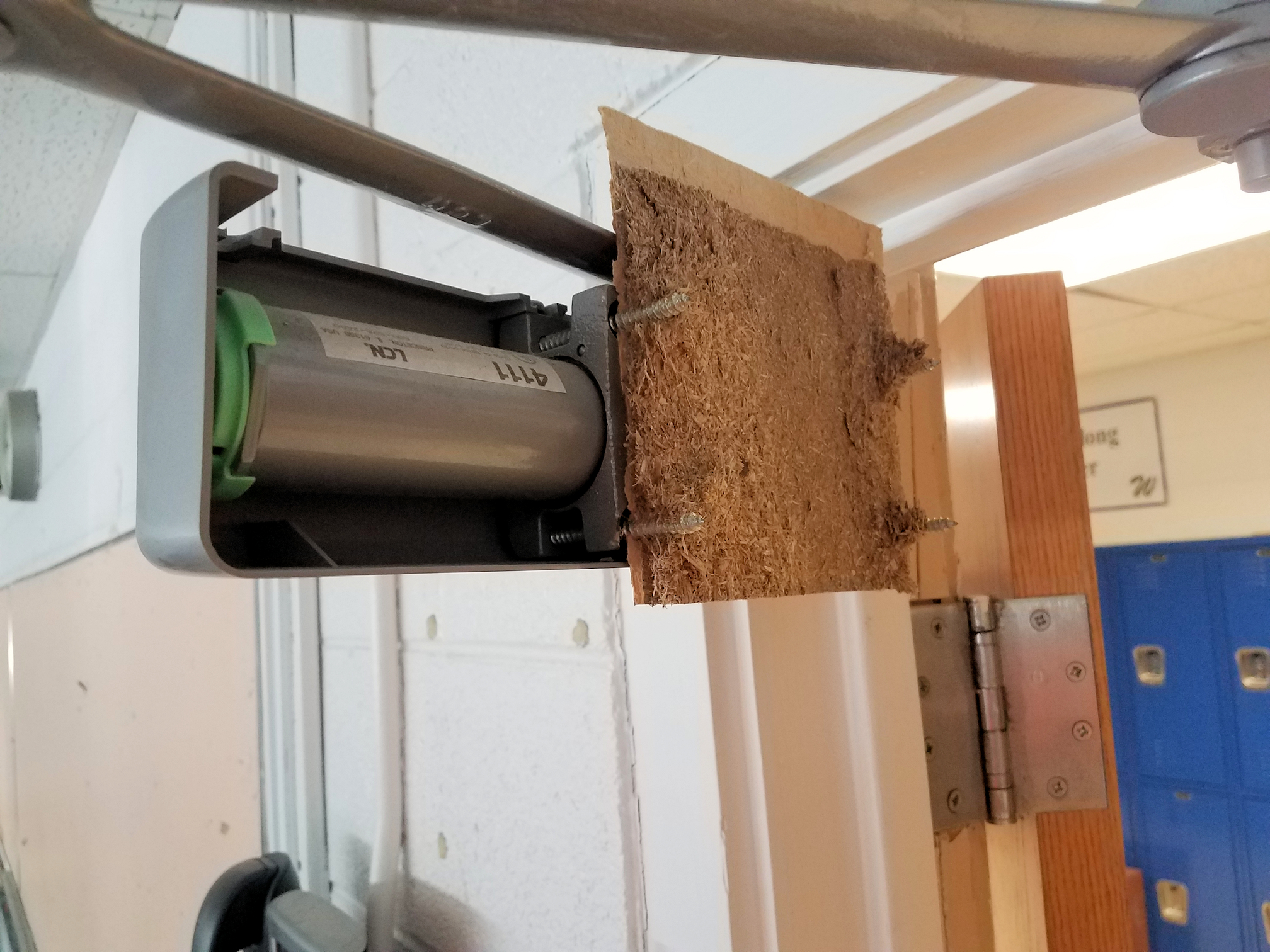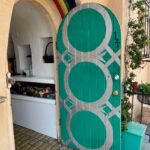The days are starting to run together after almost 5 weeks in the house with 3 teenagers, 2 dogs, 3 cats, 3 ferocious foster kittens, and my husband, but it’s Fixed-it Friday! Today’s photos were sent in by Chad Tengler of S&S Builders Hardware.
I know that some architects would rather not see thru-bolts for closers, but I think they should be standard for every school specification. Do you agree?
You need to login or register to bookmark/favorite this content.







I wonder if door inspections is in the “Crisis Management”
Flip cards???
That material doesn’t look like top blocking core. I know certain wood door manufacturer’s will not warranty a stop arm closer installation on their door if not blocked (for reasons like this). I hope they are covered.
My opinion is there should always be through bolt on a school job. If you can’t get that approved at least block the parallel arm applications for over torquing.
I wonder if the specifier really meant to get tear-away door cores?
Those are awesome photos. Any heavy duty use would qualify in my book.
If the architect does not want through bolt then spec the correct top rail in the wood door. Just particle core will not cut it.You need a solid top rail blocking.
And that is exactly why we specify all our closers with TBSRT!
I do not agree with Thru Bolts. It is a door issue and – Not – a hardware issue. If the Door was ordered correctly with a 5″ top rail this wouldn’t have happened.
Agree 100%. Required on all my school specs.
I like to see the use of proper blocking in the door first. Then use the correct screws as suggested in installation instructions with the correct sized predrilled holes for those screws, located accurately so there are no angled screws installed. That way if there is a failure at some point in the life of the door the use of through-bolts may be able to repair the stripped out the mounting screw and in that way correct the closer mounting issue. Of course, the failure shown here seems more like not having the correct blocking or backing core in the door, to begin with, versus the choice of not using through-bolts to mount with.
Thanks,
Stay safe, stay healthy and stay 6 ft apart in our new world.
“some architects would rather not see thru-bolts for closers” As long as wood screws are included in the closer pack guess what will be used first??
It is a provision of my spec that all surface mounted door hardware be through bolted. I don’t allow self-tapping screws. I don’t allow impact tools for installation.
I agree. They can be fussy. But utility trumps looks every time. Not a positive ad for the door, either.
too much back check- impatient user (speaking from experience)
Is the replacement door waiting across the hallway (in photo with blue lockers)?
When the spec calls for no thru bolts, but also calls out handed closers and cush stops in a school. Priceless or may the price of a door.
Dont see a label on the door but assuming its rated 20 min, i would have thru-bolted it anyway . So that this does not happen.
Note that the proper mounting for particle board doors is through bolts with grommet nuts, not sex bolt which are intended for hollow metal doors.
One of our K-7 schools had some work done by a contractor, part of which included replacing the closers on the exterior doors. The doors originally had LCN 4111 closers (out standard closer) but the job was specced with LCN 4040 closers which have a different bolt pattern. The contractor installed the closers using SRT (Self reaming and tapping) screws and they left the existing female parts of the thru-bolts in place to fill the holes. Of course, some of the thru-bolts were loose so to secure them they repurposed the arm to body screw to hold them in place relying on gravity to hold the arm on the closer. This wasn’t picked up on inspection and lasted a number of years without anyone noticing it, until….A door leading to the sports field had had it’s doorstop broken off, and the force of the kids flinging it past the closer’s full opening eventually caused the closer body to come off the door and, without the arm bolt in place it plummeted toward the ground hitting a child on the shoulder causing injury. Luckily it didn’t hit her on the head as she would have been killed. We got a “Code-red” to inspect and repair all of the closers in the school and found 18 missing the arm bolt. Sheesh!
Lors, This will probably be my last comment on I-Dig. With the Covid crisis I am taking the opportunity to take early retirement.I want to thank you for providing an invaluable resource to us “Door Geeks” The information is first rate and has become a must-read for me
All the best, Stay Saf,
Riche
What?? Congratulations on your retirement, but if you get bored or want to peruse the latest WW and FF photos, I hope you’ll come back to iDigHardware! Your insight is extremely valuable, and that won’t change just because you are retired. 🙂
– Lori
I agree with thru bolts, but I also think this was a poorly constructed door. The bottom edge of the break out is a straight line which means the top inside rail of the door was particle material and it tore out the entire face of the internal rail. It would have been much stronger with a real wood internal rail. I am also guessing that the screws were power driven in without any pilot holes and the material started to separate at the time of the installation. Not the only maintenance issue, note the other doors with an empty lock hole, trim screw hole and wrap around plate. Budget issues or total lack of common sense maintenance. Any guesses as to the composition of the windows in the other doors.
I definitely agree!
The debate over the aesthetics of thru-bolts (sex-bolts) detracting from the beauty of a wood door brings to my mind the old architectural maxim: “Forms ever follows function” coined the late 19th century architect L. Sullivan. The “function” of a door opening is clear. The aesthetic beauty “form” of that door assembly should reflect due consideration for the durable long-term “function” of the opening. This door had a nice “form” when it was first installed, but now it does not “function.”
This door was incorrectly specified / detailed for installing a closer. The wood door should have internal solid blocking for the door closer. If you ever see a thru-bolt that is too tight and caving in the surface of the wood or laminate veneer, it is evidence of a lack of internal blocking.
I recommend internal blocking for every wood door installed in environments like schools and hospitals. I also recommend blocking AND the thru-bolts for every surface-mounted hardware type. This ensures that when internal door construction mistakes are made, the door still has a more durable assembly.
With those standards for every single wood door built in a heavy use environment, you have a better “function” for the life of that opening.
I dunno, that looks to me like a materials failure on the door, specification error with the door & hardware combination, or most probably installer error.
i would expect a solid wood frame on the interior of the door for stability and anchoring – I’ll wager the wrong size door was ordered and the installer ripped off the top figuring no one would ever notice. Note the filler continues all the way to the top of the torn out area. That could be a cheapo specification.
Scrawny me, Ican rip a couple of screws out of a piece of chipboard or MDF. In a high abuse setting like a school i would not be trying to fasten anything into compacted lint like that with coarse thread screws. If wood screws failed like that, I would not trust through bolts to hold it with out a full plate on the other side.
Could the door have been specked with solid wood backing / bracing to accommodate the closer?
Lori,
Yes the door in the picture should have had through bolts.
However I disagree about all needing them. We always specify proper reinforcement when the doors need closers. I order all doors with a minimum 5” top rail for the closer in case they add one down the road then there is no need to have the through bolts.
Also all doors should have a stop as well.
The only exception would be with a Cush arm then would through bolt.
Do you agree?
Through bolts are not required provided the wood doors are ordered with he correct blocking and steel door with proper reinforcement. This is either an order error or a door manufacturing error. I agree with the use of through bolts only when the door is existing and blocking/reinforcement is unknown.
I would rather not see thru bolts. Rather reinforce doors and frames properly and install with some type of locktite or wood glue. Problem with thru bolts beyond the obvious of being unsightly, is they are almost always over tightened causing HM doors to buckle and wood doors to buckle and expose broken grain.
Very bad door to start with I would also probably put metal plates and through/sex bolts or Chicago screws
Also how did the door work in first place
A lot if differing opinions here. Many–if not all–of the architectural door manufacturers now offer the LD-2 particleboard cores. Additional blocking is not required. These photos show what looks like an older door–probably an LD-1 core, which requires thru-bolting. The bottom photo shows a split in the wood frame above and below the hinge.. That indicates to me that no pilot holes were drilled, Maybe the same installer hung the door and took a few more shortcuts with the closer mounting.
To me, thru-bolts are kind of like seat belts. I didn’t need it on my drive to work today, but I buckled up anyway.
Waterson Adjustable Closer Hinge might help.
Our closer hinge follows template hinge and provides self-closing features. Fire-rated also.
watersonusa.com
I see a lot of comments are leaning toward a poorly specified or poorly built door. That may not be the case. It is very likely that the door was ordered without blocking because the closer was specified to have through-bolts.
I used the same closers on a school project and specified them with through-bolts. I added a special note next to each closer that through-bolts must be used and went over it in the pre-installation meeting. The installer, hired by the GC, decided it would be quicker and easier to use self-drilling screws in the wood doors. Time is money so every minute saved, is money earned. Well – at least until he had to buy dozens of new doors, swap them at his expense AND go back and reinstall EVERY closer on the job with through-bolts. I’d bet the installer on this project did the same thing.
Funny this is coming up. I’m in the design and construction department for a school system and we require all closers and exit devices to be through bolted, regardless of wood or metal doors. Often times we get hardware suppliers putting together submittals saying “industry standards” do not require through bolting on metal doors. We do it on all doors.
It’s unbelievable the abuse doors and hardware see in school environments. In some cases we’ve had to install traffic style bollards outside the doors to act as “stops” to prevent the doors from swinging past the closers’ opening capability.
On another note, I believe the closer is protruding down into the opening a bit farther than allowable